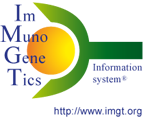Frequently asked questions
Mouse
- How to find the mouse T cell receptor alpha et beta constant genes sequences to select PCR primer sequences?
- Is there a complete list of the mouse IG and TR genes?
- Why is the mouse TRAJ7 gene considered as an ORF?
- Is there a way to cross-reference the IMGT named TRBV genes with the more common names?
- How to get alignments of parts of the mouse germline V genes in order to design subgroup specific primers for PCR amplification of the V gene repertoire?
- Is it possible to use IMGT/V-QUEST for the analysis of TRB D-J junctions?
- What is the difference in the gene content between IMGT Gene table and IMGT reference directory?
- How to obtain sequences for the design of primers to identify mouse TR alpha and beta genes in mouse T cells?
- What IMGT genes represent the old Vk21-5 and J558.40?
- What do the D and /DV in the mouse TRA genes mean?
- What is the IMGT® gene match for TEPC15 and VkOx1?
- Why is it possible to find identical IMGT names for different genes?
- How to design V primers to sequence a monoclonal antibody Fab for which only partial V domain amino acid sequences (motifs) are known?
- How to download the amino acid sequences (in fasta format) of the IG variable regions from mouse?
